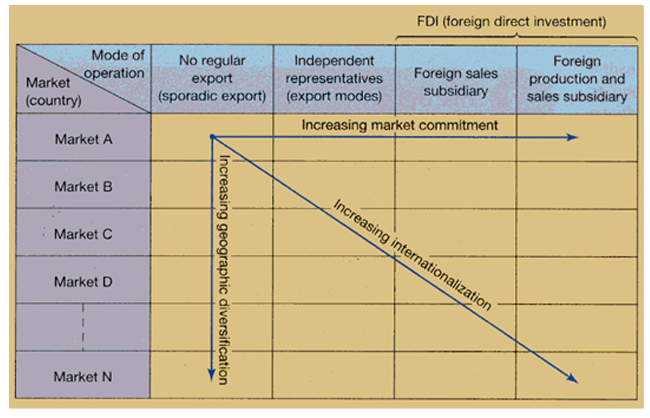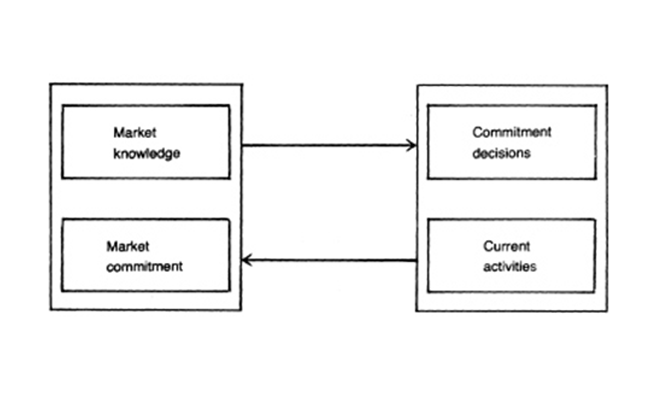The Uppsala Model has been one of the most discussed dynamic theories in Nordic School and International Business Studies and has affected many researches in the way to explain the process of internationalization of companies. This paper highlights the limitation of The Uppsala Model in order to describe the process of internationalization of companies in the new era of globalization. First, I attempt to describe the theory itself, before to emphasise the changes in international business environment and its impact on the model and its limitation.
Keywords: Uppsala model, Uppsala modellen, Internationalization model, Internationalization theory
The Uppsala Internationalization Model
Swedish researchers (Johanson and Wiedersheim-Paul, 1975; Johanson and Vahlne, 1977) from Uppsala University had vast criticisms of the theories at the time, which explained international involvement. They believed most existing theorises at that time toned down the problems of cultural differences and ignored the internal foundations needed so that companies could handle international activities. As a result Swedish researchers developed their own model as a more independent model to explain the sequential steps in the direction of increased foreign dedication (Johanson & Vahlne, 1977; 1990)[1]. The model was based on empirical observation from four Swedish manufacturers and influenced by the works of Penrose (1959), Cyert & March (1963), Aharoni (1966) Vernon (1966) and others. The Uppsala Internationalization Model distinguishes four different steps of entering an international market, which cannot be viewed independently of a company’s situation, market and the market knowledge. (See Fig. 1:1 below)
- Step 1: No regular export activities (sporadic export).
- Step 2: Export via independent representative (export mode).
- Step 3: Establishment of a foreign sales subsidiary.
- Step 4: Foreign production/manufacturing.
(Hollensen 2007)[2]
From the observation, they find out that companies normally start their expansion in a psychic nearby market. There, they have enhanced knowledge of the market and more control of resources, thereafter gradually when the companies have become more experienced and acquired better resources, they expand to the more distance market. (By distance market, they refer both to the cultural distance; as well the differences in language, politics, geographical and the difficulty to acquire knowledge and information from the market)[3]. Secondly, most often companies entered a new market through export before establishment of foreign sales subsidiary or foreign production.
Figure: 1:1 Internationalization of the firm
Source: adapted from Forsgren and Johanson, 1975
In their study, they refer to (Aharoni, 1966) about the interdependence of market knowledge and market commitment and they develop a matrix model to illustrate the positive correlation between market knowledge and the commitment decisions, as well to emphasize the sequential development of market activities and its positive correlation to market commitment. The core explanation of the model is that increased market knowledge will lead to increased market commitment, and vice versa. (Andersen, 1993)[4]
Figure 1.2 The Basic of Internationalization-State and Change Aspects
They make a distinction between general knowledge and the specific knowledge. The former, which is more about the operation in the foreign market, can easily be transferred from one market to the other. It is important to note that the special knowledge, which is more specific to a particular market, cannot be achieved without specific activity in that market and it would be difficult to use this knowledge in other markets.
Uppsala-Model’s limitation in the new global era
Even though the Uppsala Model has contribute greatly to broader understanding of internationalization process of companies but the model itself suffer in some fundamental bases to describe the Total Internationalization Process as it meant to be its original unit of analysis, even before we consider the changes in business environmental during the last 20 years and its impact on the theory’s development. For example the model dose not shows much consideration to management incentive and its effect on decision making, or when they introduce the sequential four steps of market entry they ignored some other forms of market entries which are difficult to place on the model’s scale, such as franchising which is considered to be a relatively less risky market entry and have the opportunity to build great market coverage and control (Doole, I & Lowe, R, 2008)[5], or licensing which requires low levels of investment and provide considerable control over the market (Doole, I & Lowe, R, 2008)[6] or strategic alliance and some other market operation. Other shortfall in the model is that it dose not discuses the reason behind foreign direct investment and why should it be a desire as the ultimate market operation, or why should/would companies follow that step development. For example, why the export mode could not be the final step of internationalization?
However in the last 20 years the advancement in telecommunication, transportation and production technology has been enormous. The technology development has been probably the most influenced factor in the process of globalization and has both changed the contemporary business environment and provided means for the firms to responding to this change faster and better then before.[7] As the same time we have witnessed tremendous changes in international trading environment, while the emerging economies such as China, India, Brazil and Russia are becoming major players in the international trade as well reduction of barriers to world trade through WTO, IMF and various trading groups and agreements,[8] and in the other hand increasing cultural de-territorialisation as each culture is penetrated by the influences of other cultures[9] has major influence on consumer behaviour and market situation.
Technology development and globalization
Rapid technology development and globalization has brought opportunity as well challenges to field of international businesses. Looking at the u-model in the contemporary business environment it highlights even more deficit in the original model which needs to be looked over and evolved in order to describe the internationalization process of modern companies. For example the original model has look at internationalization process purely as an internal capability and has ignored external factors such as market potential and competitive forces which has become more important in the global world and in some case even override the psychic distance factor in the management decision making.[10]
Johanson and Vahlne (1990)[11] presented no limits on the units of analysis for they model and have applied a broad generalization in their interpretation. It brings up the question whose behaviour were they describing? SMEs, LSEs or MNCs…, however they mentioned, that large firms can be expected to take larger internationalization steps than small firms. But how would this imply to firms from emerging economies such as China and India? For example there is much evidence that Indian IT and pharmaceuticals companies primarily targeting USA and European market[12].
Growing service industries in developed countries
Service industries accounted for approximately 70% of total economic activity in the United States in 2006,[13] and approximately 60% for EU-27[14] and it has been one of the fastest growing industries sector in the industrial world. Even though considering the importance of service sector, most international business researches had had product orientated focus including U-model. Reihlen & Apel (2005)[15] described the service sector as highly knowledge-intensive, provided by highly educated people, involve a high degree of customization, interaction, discretionary effort and personal judgment by the professional(s) delivering the service. However as the product manufactories has been the primarily focus of U-Model, a drawback for it is the failure to predict or describe the service industries behaviour in their internationalization process. For instance Reihlen & Apel (2005)[16] find out that unlike more traditional firms that move gradually into international markets, Born Global firms internationalize quickly and contradictory to U-Model which believe market knowledge can only be acquired through activities on the market (experimental knowledge) (Forsgren & Johanson, 1992)[17] Born Global Firms combine the experimental learning with other modes of knowledge creation such as learning through grafting, imitating or searching (Saarenketo et al., 2004)[18]. Like when the Swedish & Danish engineers Niklas Zennström and Janus Friis started their VOIP company’s “Skype” in 2003, from very early beginning the company started to use international recourses as they registered the company in Luxembourg, using American Bank finance and a team of software developer based in Tallinn and Estonia and within few months they expanded their services to the global market simultaneously.
The change in trend of internationalization process for Born Global firms could be due to that world has become much more homogeneous and that consequently psychic distance has decreased, as Nordström argued in 1990,[19] however in the last few years we have been witnessing a complete reverse of internationalization process in entertainment and music industry such as many European and American artists looking for the successes in Tokyo and Japanese market even before the home market. Those artists after had released their work successfully in Japanese market and has acquired the resources and experiment then launch their work for the home market…
Extracted from the paper “The Uppsala Internationalization Model and its limitation in the new era” Author: Tony Zohari, Stockholm University School of Business.
Related articles:
- Internationalization of SMEs
- The presentation of culture in international business textbooks
- Managing talent across national borders: the challenges faced by an international retail group
- Globalization and its effects on developing countries
- Classical International Trade Theory
- What you should know about China before entering the Chinese market.
- Marketing Mix
Ref:
[1] Johanson, J. & Vahlne, J.-E. (1977). The Internationalization Process of the Firm – A Model of Knowledge Development and Increasing Foreign Market Commitments. Journal of International Business Studies.
Johanson, J. & Vahlne, J.-E. (1990). The Mechanism of Internationalisation. International Marketing Review.
[2] Hollensen S. Global marketing, 4th edition 2007, Pearson Education Limited, pp 63
[3] Ibid, pp 64
[4] Andersen, O. 1993. On the Internationalization Process of Firms: A Critical Analysis, Journal of International Business Studies, Vol. 24, No. 2, pp. 209-231
[5] Doole, I & Lowe, R, International Marketing Strategy, 5th Edition (2008), pp 243-244
[6] Doole, I & Lowe, R, International Marketing Strategy, 5th Edition (2008), pp 248-249
[7] Doole, I & Lowe, R, International Marketing Strategy, 5th Edition (2008), pp 419
[8] Doole, I & Lowe, R, International Marketing Strategy, 5th Edition (2008), pp 38-65
[9] Doole, I & Lowe, R, International Marketing Strategy, 5th Edition (2008), pp 85
[10] Hollensen S. Global marketing, 4th edition 2007, Pearson Education Limited, pp 64-65
[11]Johanson, J. & Vahlne J.E. 1990, The mechanism of internationalization. International Marketinzg Review, 7(4): 11-24
[12] Kundu, S.L., India Inc goes global, http://www.atimes.com/atimes/South_Asia/GK29Df01.html , 22 October 2008
[13] Service Annual Survey, 2006, U.S. Department of Commerce, http://www.census.gov/svsd/www/services/sas/sas_data/historical/sas-06.pdf 22 October 2008
[14] Pekka ALAJÄÄSKÖ, Industry, trade and services, European Communities, 2008 22 October 2008
[15] Reihlen, M. & Apel, B.A., (2005) Internationalization of professional service firms as learning – a constructivist approach, Department of General Management, Business Policy & Logistics, University of Cologne, Koln, Germany
[16] Ibid
[17] Forsgren, M. and Johanson, J. (eds.), 1992, Managing Networks in International Business. Philadelphia: Gordon & Breach. P10
[18] Saarenketo, S., Puumalainen, K., Kuivalainen, O. and Kylaheiko, K. (2004), “Dynamic knowledge-related learning processes in internationalizing high-tech SMEs”, International Journal of Production Economics, Vol. 89 No. 3, pp. 363-78.
[19] Nordström, K.A. (1990), The Internationalization Process of the Firm in a New Perspective, Institute of International Business, Stockholm
[20] Doole, I & Lowe, R, International Marketing Strategy, 5th Edition (2008), pp 382
[21] Sir Ken Robinson: How schools kill creativity. http://www.ted.com 15 April 2014
[22] Seth Godin: How to get your ideas to spread (2003) http://www.ted.com 15 April 2014









